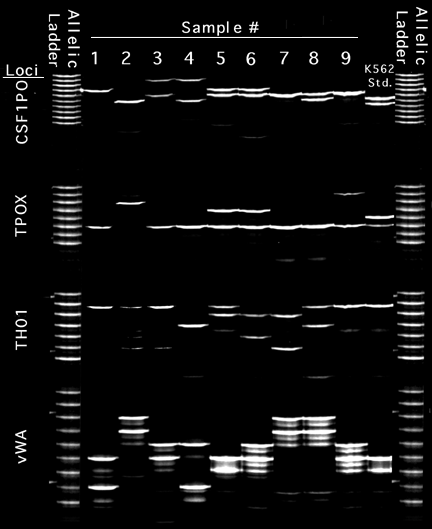
There are several types of testing used by forensic scientists:
RESTRICTION FRAGMENT LENGTH POLYMORPHISM (RFLP),
POLYMERASE CHAIN REACTION (PCR),
SHORT TANDEM REPEAT (STR) .
Today, genetic testing in police forensic labs is helping catch and prosecute criminals. Medical science's quest for mapping the human genomedeveloped the tools that forensic scientists can use in the lab to connect a person to a crime scene via any tissue sample from the scene: hair and nails, blood, semen, cigarette butts, paraffin embedded tissues, bone, teeth, and muscle tissue.
Forensic DNA evidence is now one of the most conclusive forms of evidence that can be presented in court today, and it has met the Frye standard for admissibility of evidence. In a case where DNA evidence is present, the accused often plea bargan due to the accuracy of putting them at the crime scene, and trials are shorter (thus saving money). It can also be used to identify dead bodies. Other applications of this test are cases where family lineage is in dispute, especially paternity tests. Law enforcement agencies are currently compling DNA fingerprints of criminals for a massive database for future use in solving crimes. Criminals go do what they wish to change their appearance, but they can never alter their DNA fingerprint. This makes a DNA database ideal for cross referencing know criminals with DNA evidence found at an unsolved crime.
What are they looking for?
DNA (deoxyribonucleic acid) is the "genetic blueprint" that codes for all characteristics such as eye color, hair color, facial and body features, etc. for a person. Although the majoriity of sequences are similar in everyone, a small portion of the DNA is unique and persents identifing markers to individual. These unique markers are what is studied in forensic cases.
The testing
 |
There are several types of testing used by forensic scientists: RESTRICTION FRAGMENT LENGTH POLYMORPHISM (RFLP), POLYMERASE CHAIN REACTION (PCR), SHORT TANDEM REPEAT (STR) . |
RFLP:Is the most widely accepted of all DNA evidence for court use. RFLP is highly discriminating due to the highly polymorphic locations of the genetic sequences. This means that the odds that a another person would have a matching trait are low. The combined probability of testing 5 or 6 separate locations can yeild the problablility of a match to greater that a million to one. The only disadvantages to this test is that it requires a high quality of DNA from the sample, the quantity of sample needed to test (need about a quarter size blood stain as an example), and the 3-4 weeks needed to perform the test.
PCR:Is relatively new. It offers the advantage of smaller quantity of material to test, quality of DNA sourse doesn't have to be as high, is faster (results it 48-72 hours on average), and is really sensative (a single hair follicle is enough to test). This method is often used to exclude suspects.
STR:Is also fairly new to be used in forensics. It is not as popular as the other 2 types of testing. It is generally only used to exclude people as suspects because it only analyzes short repetative DNA sequences 4-5 base pairs in length.
Basic DNA Testing Procedure

To obtain a DNA fingerprint of an individual, scientists first extract DNA from a tissue sample - blood, skin, hair, semen, etc. They then cut the DNA into pieces using an enzyme that cuts either side of a repeated sequence. The result is a mixture of DNA segments of many different sizes. These fragments are arranged according to size via electrophoresis: the solution of DNA is placed on a flat plate of gel where an electric current is applied through the gel. DNA is negatively charged so it moves towards the positive electrode (smaller the DNA fragment the faster it moves). The separated segments of DNA are transferred from the gel to a nylon membrane and the strands in each DNA segment are chemically split. The DNA is then labelled with single strands of a radioactive gene probe and an X-ray picture is made of the pattern of bands creating the "fingerprint".

This page designed with IE 4.0 on a screen resolution of 800x600.